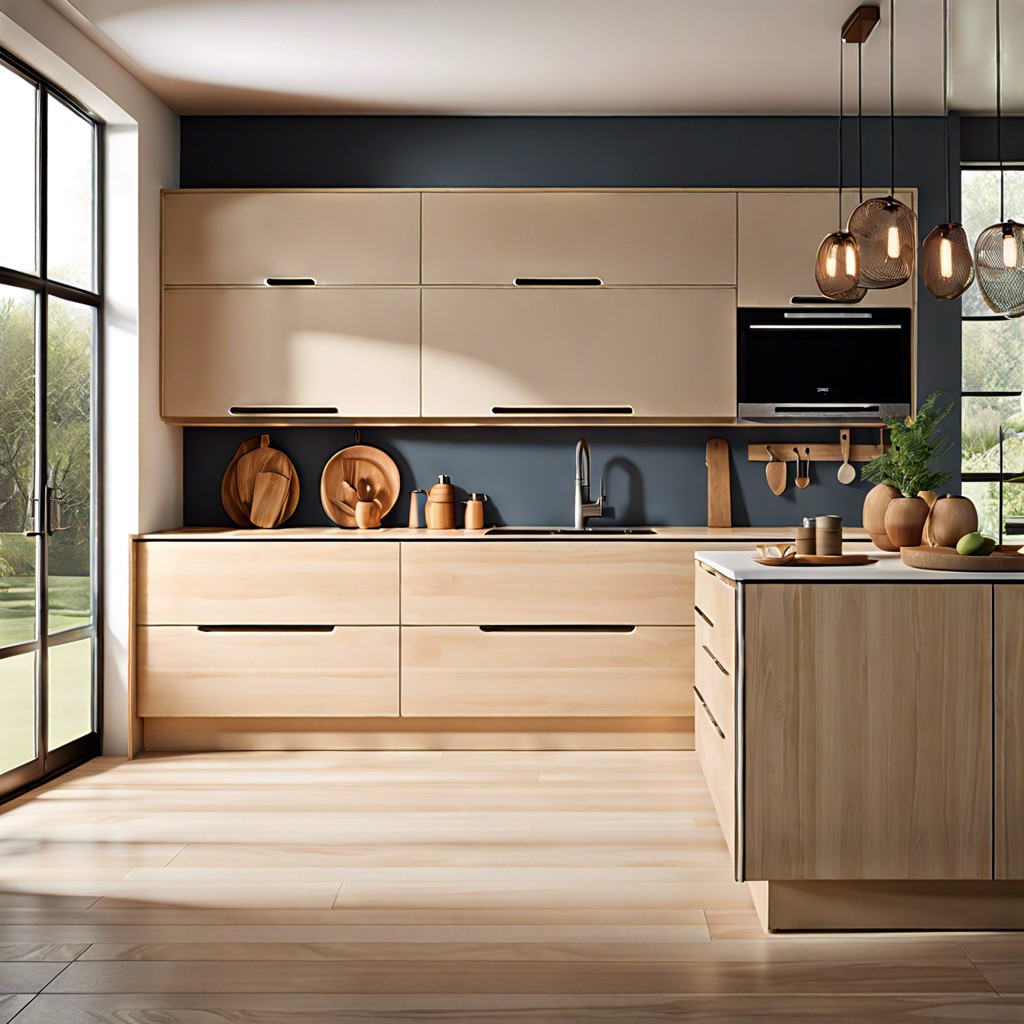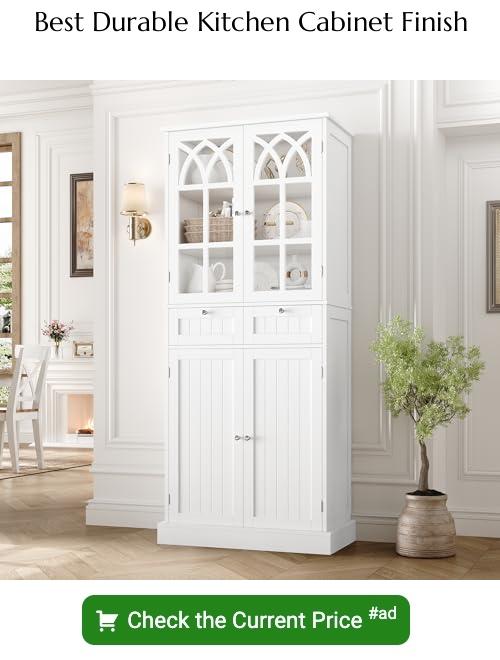Last updated on
Choosing the right finish for your kitchen cabinets can enhance durability and aesthetics—learn about the best options for a stylish and functional kitchen space.
Key takeaways:
- Varnish, stain, paint, and glaze are common finishes for kitchen cabinets.
- Semi-gloss is the most durable finish for kitchen cabinets.
- Technique matters – clean, sand, prime, apply thin coats, and consider using a sealer.
- Semi-gloss enhances wood longevity and is ideal for kitchens.
- Regular cleaning and maintenance will keep kitchen cabinet finishes looking their best.
What's Inside
What Is A “Finish”?

A finish on kitchen cabinets serves as a protective layer, shielding wood and engineered materials from moisture, heat, and everyday wear and tear. Think of it as the cabinet’s armor; it’s a critical component that also defines the look and feel of your kitchen space.
There are several types of finishes, each with its unique properties:
- Varnish enhances the natural beauty of wood, offering a durable surface that can withstand daily kitchen activities.
- Stain, which penetrates the wood, alters the color while allowing the grain pattern to shine through, combining aesthetic appeal with protection.
- Paint, a popular choice for its versatility, provides a uniform color and can help disguise lesser quality wood.
- Glaze is a semi-transparent coating that settles into the grooves of wood, adding depth and dimension to the cabinet’s features.
Each of these finishes can be further customized in terms of sheen level, from matte to high gloss, each presenting its own method of interaction with the kitchen’s aesthetics and lighting conditions.
Durability of Different Finishes: Semi-Gloss, Gloss, and Satin
When choosing the right finish for kitchen cabinets, durability is a top consideration. Everyday kitchen activities can take a toll on cabinet surfaces, so let’s delve into the pros and cons of semi-gloss, gloss, and satin finishes.
Semi-gloss finishes strike a balance. They are less shiny than gloss, minimizing imperfections, yet still easy to clean. This resilience to moisture makes semi-gloss a strong contender for kitchen environments where splashes and spills are common.
Gloss finishes, on the other hand, offer the most shine. They’re superb at reflecting light, making spaces appear larger and brighter. However, they tend to highlight surface imperfections and may require more frequent cleaning to maintain their luster.
Satin finishes boast a velvety, soft sheen, which is more forgiving of surface flaws. They’re less reflective than gloss and semi-gloss, which can be beneficial in rooms with natural light. Satin’s durability is commendable, withstanding daily usage well, though it may not be as moisture-resistant as semi-gloss.
Each finish represents a different approach to dealing with kitchen realities, from busy breakfasts to simmering sauces. Considering your lifestyle and kitchen usage will guide you to the finish that marries durability with your personal aesthetic.
Technique: Painting Process for Kitchen Cabinets
The success of your kitchen cabinet finish largely hinges on your chosen painting technique. Here’s a distilled insight into the process:
Start by meticulously cleaning your cabinets. Any residual grease or grime can thwart paint adhesion, so use a degreaser and allow the surfaces to dry thoroughly.
Next, remove hardware and doors. Labeling them can save you a headache during reassembly. Lay the doors flat for painting; this minimizes drips and helps achieve a smoother finish.
Sanding is your friend for flawless paint adherence. A medium-grit sandpaper will rough up the surface just enough for the primer and paint to grip effectively.
Don’t scrimp on the primer! Apply a high-quality primer designed for your cabinet’s material. This step ensures the paint durability and color integrity.
When it’s time to paint, apply thin, even coats, and be patient. Several thin layers are superior to one thick layer, as they dry harder and are less likely to chip.
Finally, consider using a sealer, especially on cabinets that experience heavy use. It acts as a protective coat, safeguarding your hard work from the wear and tear of daily life.
Remember, the right technique can make or break the longevity and appearance of your finish. Take your time, pay attention to detail, and your kitchen cabinets will thank you with their enduring beauty.
The Verdict: Which Finish Is The Most Durable?
When it comes to the most durable finish for kitchen cabinets, the consensus leans towards semi-gloss. This finish strikes an ideal balance between usability and resilience. The higher sheen levels in semi-gloss make it impervious to moisture and easier to clean, crucial attributes given the kitchen’s exposure to spills and splatters.
The gloss finish, while reflective and stylish, can highlight surface imperfections and require more frequent cleaning due to more visible fingerprints and smudges. On the other hand, satin finishes, while providing a classic look, do not fare as well when subjected to the rigors of a busy kitchen, as they are less durable and can show signs of wear more quickly.
Semi-gloss finishes come with an added bonus: they enhance the longevity of the wood beneath by sealing the pores against contaminants. This is especially beneficial for areas around the sink or where food is prepared, where cabinets are most at risk.
In summary, for kitchen cabinets that will last the test of time and use, semi-gloss emerges as the clear frontrunner on the durability track. It’s the sweet spot that harmonizes practicality with the day-to-day demands of a kitchen environment.
Maintenance and Upkeep of Kitchen Cabinet Finishes
Maintaining the luster and functionality of your kitchen cabinets involves routine care that doesn’t require excessive effort. Depending on the finish you’ve chosen, the approach may vary slightly.
For painted cabinets, regular wiping with a soft, damp cloth can prevent dust and grime build-up. Once a month, a gentle cleanser diluted with water is recommended to keep the surfaces pristine, followed by a dry towel to avoid moisture damage.
Wood finishes, such as stained or varnished surfaces, benefit from specialized wood cleaner. This keeps the wood nourished and prevents the finish from dulling over time. Avoid using harsh chemicals as they can strip the finish and damage the wood.
Lacquered cabinets have a more delicate surface, often requiring just a damp cloth for cleaning. For tougher stains, a mild soap solution can be used sparingly. It’s important to avoid ammonia-based cleaners which can cloud the lacquer.
For high-gloss finishes, microfiber cloths are ideal for eliminating fingerprints and smudges without scratching the surface. A mixture of vinegar and water can act as an effective natural cleaner for such finishes.
Always remember to dry any wet spots, as prolonged exposure to water can damage cabinet finishes. Occasionally check hinges and hardware for functionality and tightness. With these simple yet effective maintenance habits, your kitchen cabinets can remain in excellent condition, providing both beauty and utility to your home for years to come.





